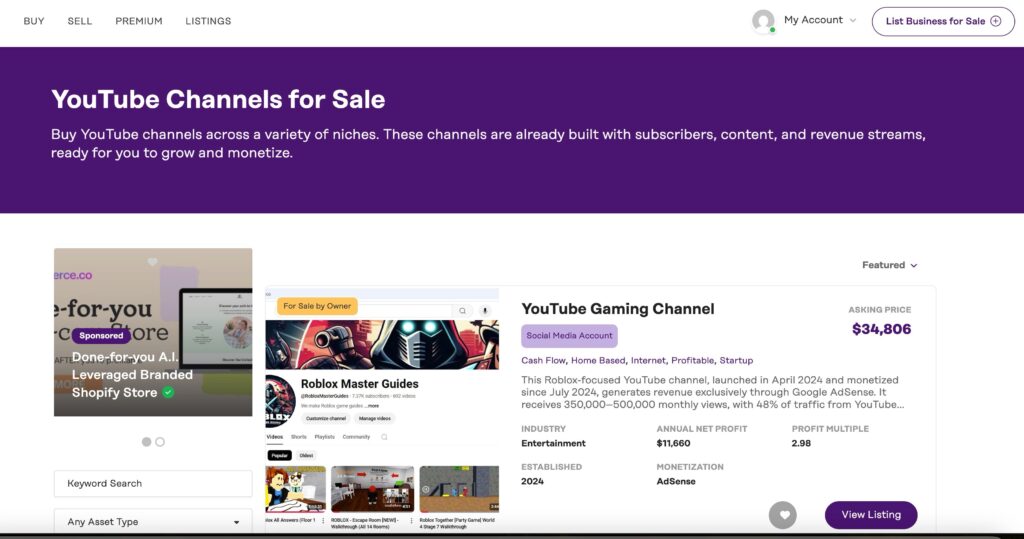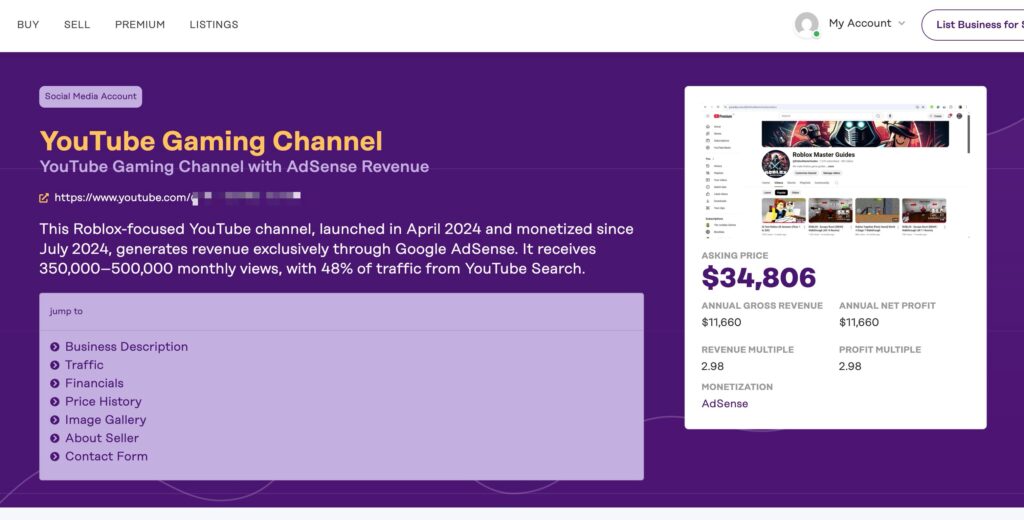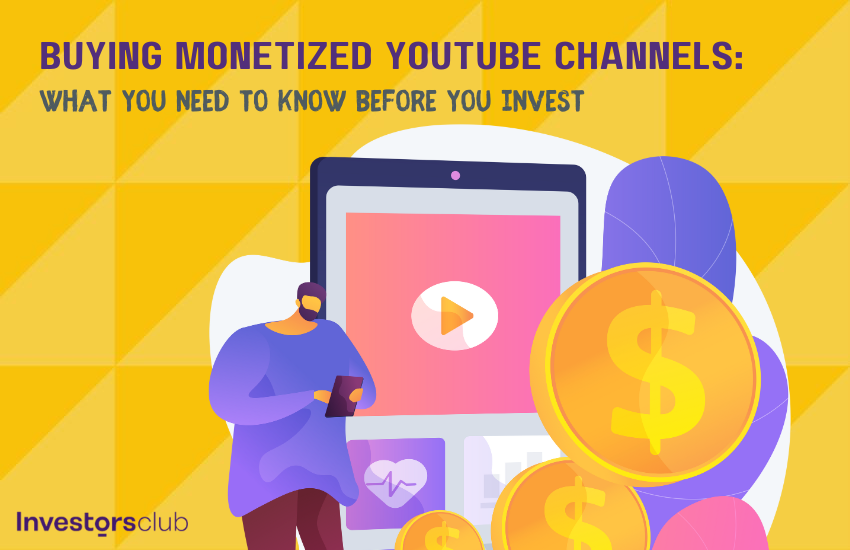You’re staring at a YouTube channel listing: 50,000 subscribers, $800 monthly revenue, asking price $15,000. The seller claims it’s a “passive income goldmine” that will pay for itself in 18 months.
Is it too good to be true?
Maybe.
Maybe not.
John bought a similar channel for $1,749 and watched it collapse within weeks. Lisa purchased a 30,000-subscriber tech channel for $3,200 and doubled its revenue within a year.
The YouTube channel acquisition market is flooded with both opportunities and disasters waiting to happen. At Investors Club, we’ve seen both the spectacular wins and the expensive failures. The difference between success and failure often comes down to understanding what you’re actually buying and what can go wrong.
Let’s see what actually works when buying YouTube channels in 2025.
Can You Legally Buy a YouTube Channel?

YouTube’s Terms of Service are not exactly clear – and this is why you will see so many conflicting answers to this question. While YouTube’s Terms of Service don’t explicitly say “you can’t sell your channel”, they forbid “selling access to the Service”.
What you’ll see happening is that YouTube typically only acts when transfers result in obvious violations—spam content, fake engagement, or user disputes that draw attention to the sale. Most legitimate transfers fly under the radar.
The AdSense Roadblock
This is where many buyers get blindsided: a channel’s monetization depends on a Google AdSense account, and Google explicitly prohibits AdSense account transfers between individuals.
This means that:
- The seller must disconnect their AdSense account before transfer
- You must reapply for monetization with your own AdSense account
- Expect 7-30 days for approval (during which you earn nothing)
- No guarantee your application will be approved
The Professional Workaround
For larger acquisitions, buyers use the “LLC method”: they structure deals where the YouTube channel is owned by a limited liability company, then purchase the LLC itself. Since the account technically hasn’t been “sold”—just the business ownership changed—this doesn’t directly violate YouTube’s Terms of Service.
Major Risks That Destroy Investments
The Dead Subscriber Trap
Here’s a counterintuitive truth: dormant channels with large subscriber counts often perform worse than fresh channels started from scratch. This happens because inactive subscribers actively hurt a channel’s performance.
YouTube’s algorithm calculates engagement rates using the entire subscriber base. If 90% of your subscribers are inactive—whether they’re real people who’ve lost interest or bots—the algorithm sees terrible engagement metrics and stops recommending your content.
Here is a simple math:
If a channel with 100,000 inactive subscribers is getting 1,000 views, it appears to have a 1% engagement. If a fresh channel with 1,000 subscribers is getting 1,000 views, it appears to have a 100% engagement. Guess which one YouTube promotes to the viewers?
The Demonetization Risk
YouTube is actively penalizing channels if it detects any of the following:
- Content policy violations: Channels get demonetized for “reused content” when new owners change direction
- Algorithm penalties: Sudden content style changes trigger reduced distribution
- Ownership detection: Monetization removal when YouTube detects transfers
Real example: One creator bought a channel, posted original content for 28 days, built momentum to 40,000 daily views, then YouTube demonetized it for “reused content”—despite the creator proving all content was original.
Hidden Liabilities
When you buy a channel, you inherit its entire history:
- Existing copyright strikes and policy violations
- Pending legal disputes or takedown notices
- Multi-Channel Network contracts and obligations
- Algorithm penalties from previous content
These hidden issues can destroy your investment overnight.
Where to Buy Channels Safely
YouTube’s TOS ambiguity has created a thriving marketplace where thousands of channels change hands monthly with minimal platform interference.

Recommended Platforms
Investors Club offers the cleanest approach—free listings with direct seller contact and no commission fees. You handle your own transaction – no broker interference and no fees.
FameSwap provides built-in escrow services and user review systems. They charge 10% commission but offer verification services that can prevent obvious scams.
Motion Invest takes a professional broker approach with a vetting process. Higher fees (8-12%) but includes due diligence reports for channels typically valued at $10,000+.
Empire Flippers recently expanded into YouTube channels. They handle higher-value acquisitions ($30,000+) and have a vetting process.
Platforms to Avoid
ACCS Market has multiple user complaints about sellers who disappear after payment. The platform lacks adequate buyer protection and dispute resolution mechanisms.
| Platform | Fee Structure | Best For | Protection Level |
|---|---|---|---|
| Investors Club | Free | 1K–100K subscribers | Self-managed |
| FameSwap | 10% commission | 5K–50K subscribers | Full escrow |
| Motion Invest | 8–12% commission | 10K–500K subscribers | Professional vetting |
| Empire Flippers | Variable commission | Premium channels $10K+ | Comprehensive |
| ACCS Market | Variable | AVOID | None |
The Transfer Process
Escrow
For substantial purchases or unknown sellers, escrow is essential. Professional escrow services hold funds until ownership successfully transfers, and it protects both parties.
Typical escrow process:
- Buyer deposits funds with escrow service
- Seller makes buyer a channel manager
- Waiting period for YouTube’s ownership transfer
- Escrow releases funds after successful transfer confirmation
For smaller, direct transactions through established platforms like Investors Club, experienced buyers often manage security through PayPal’s buyer protection or credit card dispute mechanisms.
Transfer Methods
Brand Account Method (Recommended):
This is the cleanest approach that doesn’t violate account-sharing rules:
- Seller adds you as owner/manager through YouTube’s official system
- You gain full control without password sharing
- Seller removes themselves after verification period
Personal Account Method (Higher Risk):
More common but riskier:
- Seller provides Google account login credentials
- You immediately change password, recovery email, and enable 2FA
- Seller should have no other services tied to that Google account
YouTube Channel Valuations: What to Pay
As a rule of thumb, expect to pay 12-36x monthly revenue. Which end of the range is often based on these factors:
- Growth trajectory: Growing channels command higher multiples
- Niche: Evergreen content gets premium pricing, certain niches are more valuable than others
- Engagement quality: Authentic audiences worth more than dead subscribers
- Content library: Large catalogs of high-quality original performing videos increase value
Example: A channel earning $2,000/month might sell for $24,000-$72,000 depending on these variables.
Valuation Red Flags
- Unrealistic multiples: Sellers asking for 50x+ monthly revenue without exceptional growth metrics
- Revenue inflation: Claims of high earnings without corresponding view counts or engagement
- Subscriber-based pricing: Valuations based primarily on subscriber count rather than actual revenue
- Hidden costs: Channels requiring expensive content creation or management to maintain revenue
Understanding Channel Economics
How much money you can make with a YouTube channel?
RPM by niche (Revenue per 1,000 views):
- Finance/Business: $20-30 RPM
- Technology: $10-15 RPM
- Gaming: $2-3 RPM
- Children’s content: $1-2 RPM
Realistic Income Examples
YouTube channel earnings follow a straightforward formula, but the variables can dramatically impact your results. Here’s the basic calculation:
Monthly Revenue = (Monthly Views ÷ 1,000) × RPM
Where RPM (Revenue Per Mille) is your revenue per 1,000 views after YouTube takes its 45% cut.
Example calculation:
- Channel gets 100,000 views per month
- RPM is $5 (typical for lifestyle content)
- Monthly revenue = (100,000 ÷ 1,000) × $5 = $500
However, RPM varies dramatically by niche:
- Finance/Business: $15-25 RPM
- Technology: $8-15 RPM
- Gaming: $2-4 RPM
- Children’s content: $1-3 RPM
This means the same 100,000 monthly views could generate anywhere from $200 (children’s content) to $2,500 (finance niche).
Due Diligence Checklist
Buying a YouTube channel without proper due diligence is like buying a house without an inspection—you might discover expensive problems after it’s too late. The difference between a profitable acquisition and a costly mistake often comes down to the thoroughness of your investigation before purchase.
Smart buyers follow a systematic approach that progresses from obvious red flags to deep analytical verification. Here’s the step-by-step process that separates successful acquisitions from expensive disasters.
Phase 1: Initial Red Flag Assessment
Before investing time in detailed analysis, scan for obvious warning signs that should either end your interest or require immediate clarification from the seller.
- Monetization inconsistencies is the most common deception. If a supposedly “monetized” channel has ads disabled on recent videos, it’s not generating the revenue the seller claims. Check several recent videos to confirm ads are actually running.
- Disabled comments could signal past engagement problems or policy violations. While some creators disable comments by choice, it can also indicate the channel struggled with spam, harassment, or community guideline issues that forced the creator to restrict engagement.
- Deleted video history appears as gaps in upload schedules or missing videos that show high view counts in analytics but no longer exist on the channel. This suggests the creator removed problematic content—potentially due to copyright strikes, policy violations, or poor performance that hurt overall channel metrics.
- Geographic inconsistencies in analytics reveal potential account takeovers or suspicious activity. If a channel’s audience suddenly shifts from one country to another without explanation, or if the creator’s location changes dramatically, investigate further before proceeding.
Phase 2: Authenticity Verification
Once you’ve cleared the initial red flags, dig deeper into whether the channel’s growth and engagement are genuine.
Social Blade Analysis provides the foundation for authenticity verification. Look for sudden subscriber spikes that don’t correspond with viral videos or major promotional events—these often indicate bot purchases. Examine the subscriber-to-view ratio over time; healthy channels maintain relatively consistent engagement regardless of subscriber count growth.
Pay special attention to the relationship between views and subscribers. A channel with 50,000 subscribers that struggles to get 1,000 views per video likely has a significant portion of inactive or fake subscribers. Compare this ratio to similar channels in the same niche to establish reasonable benchmarks.
Advanced verification tools like HypeAuditor offer deeper insights. You can analyze engagement patterns to detect fake followers, provide audience quality scores, and reveal demographic information that helps assess whether the audience aligns with your content strategy.
Phase 3: Content and Compliance Review
Understanding the channel’s content history and compliance status protects you from inheriting expensive legal or policy problems.
- Copyright compliance requires careful examination of the channel’s content sources. Check video descriptions for proper licensing attributions, examine whether music appears to be licensed or royalty-free, and look for any past copyright claims in the channel’s history. Channels built on compilation content or heavy use of copyrighted material face ongoing demonetization risks.
- Community guideline compliance involves reviewing the channel’s strike history and content approach. Even resolved strikes indicate the channel operates in risky territory or has had compliance issues. Access the channel’s YouTube Studio Status page to see any current or past violations.
- Advertiser-friendly assessment determines long-term monetization viability. Channels with excessive profanity, controversial political content, adult themes, or topics that advertisers typically avoid will struggle with consistent ad revenue regardless of subscriber count or view numbers.
Phase 4: Financial Verification
Revenue claims require independent verification—never rely solely on seller statements about earnings.
- Documentation requirements should include YouTube Studio analytics screenshots showing revenue data for at least the past six months, not just cherry-picked high-performing periods. Request AdSense earnings reports that match the YouTube analytics data, and ask for explanations of any significant revenue spikes or drops.
- Real-time verification provides the strongest proof of current performance. Ask sellers to share their screen during a video call to show live analytics data, including recent revenue, traffic sources, and engagement metrics. This prevents sellers from using outdated or manipulated screenshots.
- Traffic source analysis reveals whether views come from sustainable sources. Organic search traffic and suggested video views indicate healthy algorithmic performance, while sudden spikes from unknown external sources may suggest artificial inflation through paid promotion or bot traffic.
Phase 5: Final Risk Assessment
Before finalizing any purchase, evaluate the broader risks and potential issues that could affect your investment.
- Audience retention analysis examines whether viewers actually watch the content or quickly click away. High subscriber counts mean nothing if average view duration is low or if the audience retention graph shows rapid drop-offs. These metrics directly impact algorithmic promotion and ad revenue potential.
- Competitive landscape assessment helps determine whether the niche is saturated or facing declining interest. Use Google Trends to examine search volume for the channel’s main topics, and analyze whether similar channels are growing or struggling in the current market environment.
- Content scalability evaluation determines whether you can realistically continue producing content that matches the audience’s expectations. If the channel’s success depends on expensive production, specialized knowledge you don’t possess, or content types you can’t consistently create, factor these ongoing costs into your purchase decision.
- Legal and contractual obligations may transfer with channel ownership. Check whether the channel has existing sponsorship agreements, Multi-Channel Network contracts, or other obligations that would become your responsibility. These can represent both opportunities and liabilities depending on the terms involved.
This systematic approach to due diligence takes time, but it’s the difference between acquiring a profitable asset and inheriting expensive problems. The most successful channel buyers treat this process as seriously as they would evaluate any business acquisition—because that’s exactly what it is.
Legal Protection Strategies
When you buy a YouTube channel, you’re not just purchasing a digital asset—you’re inheriting years of decisions, content choices, and potential legal liabilities that could destroy your investment overnight. Unlike buying a car where you can inspect for visible damage, YouTube channels carry hidden risks that only surface after money changes hands.
The moment ownership transfers, you become responsible for everything the previous owner did with that channel. This includes all existing policy violations, copyright strikes that haven’t resulted in takedowns yet, and even algorithm penalties from questionable content practices.
Consider what happened to one buyer who purchased a seemingly clean gaming channel, only to discover weeks later that several videos contained unlicensed music. When copyright holders eventually filed claims, the new owner faced potential lawsuits and immediate demonetization—despite having no involvement in creating the problematic content.
Your liability exposure includes:
- Copyright strikes and DMCA takedown notices
- Community guideline violations and warnings
- Existing sponsorship agreements and disclosure obligations
- Multi-Channel Network contracts with revenue-sharing requirements
- Algorithm penalties from previous spam or manipulation attempts
A solid purchase agreement acts as your insurance policy against undisclosed problems – make sure you have a good one. The contract should clearly define what you’re buying, what the seller is guaranteeing, and what happens if problems emerge later.
Essential protective clauses must include:
- Complete Asset Transfer Language: Specify that you’re purchasing not just the channel, but all associated content, thumbnails, channel art, and intellectual property rights. Without explicit language, sellers might claim they retain rights to certain elements.
- Comprehensive Seller Warranties: The seller must guarantee the channel has no undisclosed strikes, pending copyright claims, or policy violations. They should also warrant that all content is original or properly licensed, and that no third parties have claims to the channel’s content.
- Revenue Representation Protection: If the seller claims specific earnings figures, require them to provide documented proof and warrant the accuracy of all financial representations. Include provisions for clawback payments if revenue claims prove false.
- Indemnification Clauses: The seller should agree to cover legal costs and damages if undisclosed issues emerge. This means if a copyright lawsuit surfaces from their content, they pay the legal bills and any judgments.
- Non-Compete Restrictions: Prevent the seller from immediately starting a competing channel in the same niche, which could confuse your audience and damage your investment.
Next Steps
Ready to explore options? Browse monetized YouTube channels currently for sale and get familiar with current market pricing.


Comments (1)
Olatunde Dominic Agyo-sambo
September 2, 2025 at 3:36 pmIf i buy a YouTube channel in the US and I’m living and creating content in Nigeria will it affect my channel because of the location. And what’s the RPM in comedy and Nollywood movie niche